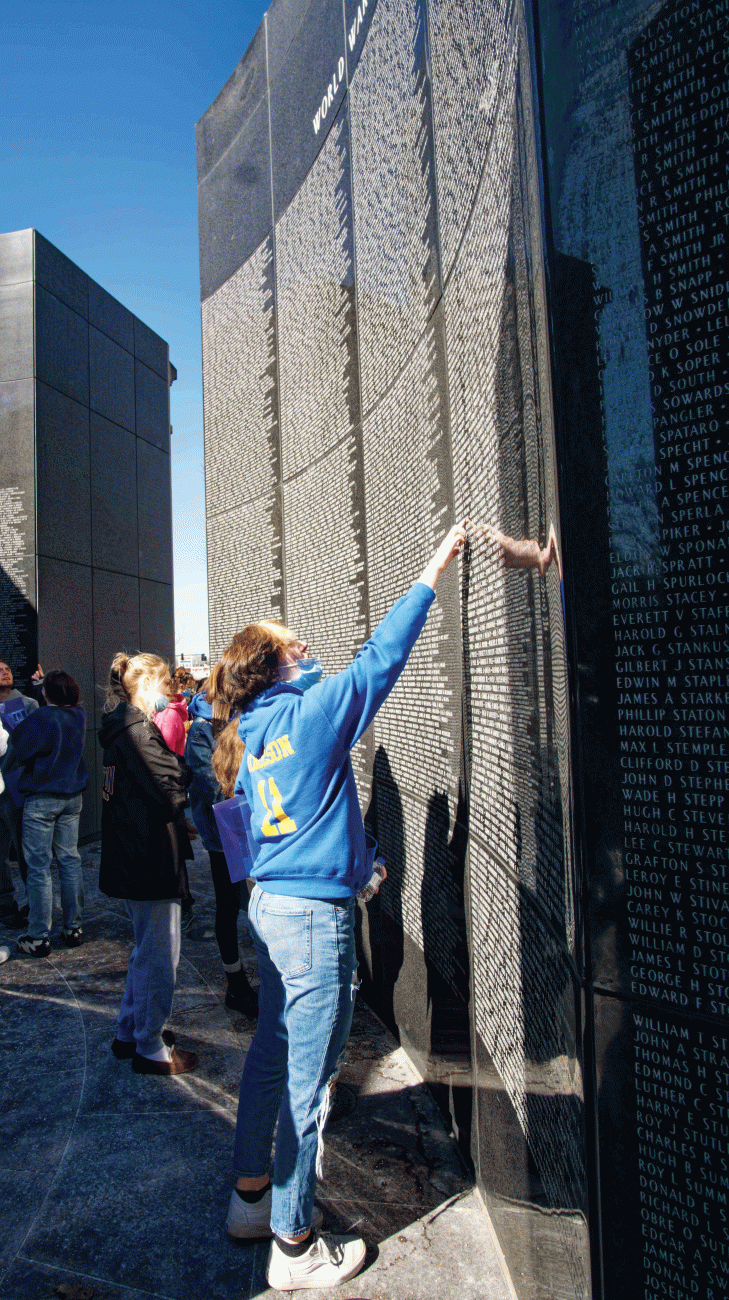Grafton National Cemetery, its boundaries marked by nothing grander than a low stone wall, sits within the small town of Grafton, West Virginia. Bordered to its northwest by a stretch of the B&O Railroad Line, the cemetery connects on its three remaining sides with residential streets and private properties. Three terrace levels, bisected by a sloped walkway, divide its grounds into six sections, comprising 3.2 well-tended acres.
Dedicated in 1868 by Arthur Ingram Boreman, the state’s first governor, Grafton National Cemetery is today the resting place of more than 2,100 veterans, representing service in every U.S. conflict from the Civil War to the Vietnam War. Along with the newer West Virginia National Cemetery about five miles west, the Grafton site is one of only two U.S. Department of Veterans Affairs national cemeteries in the Mountain State.
And on a cool spring afternoon at the nearby Taylor County Historical and Genealogical Society, a group of students, teachers, and townspeople gathered to honor and share the life stories of some of the men and women interred at the cemetery.
“I came into this project expecting some Google searches and note taking,” says Grafton High School student Jerra Halbritter. “I was completely wrong.”
The West Virginia National Cemeteries Project, created by the West Virginia Humanities Council with support from the V.A.’s Veterans Legacy Program, guides high school students in conducting primary-source research on servicemen and servicewomen interred in the state’s national cemeteries. Under the supervision of Grafton High School teachers, and assisted by scholars from West Virginia University’s MA and PhD in Public History programs, students spend months conducting team-based research on veterans they select.
For their capstone projects, students compose full-length biographies of their veterans, interweaving detailed personal and family histories with comprehensive stories of their military careers. The biographies are made available to the public at the Taylor County Historical and Genealogical Society, on the West Virginia Humanities Council’s web page, and in the Department of Veterans Affairs’s searchable online database.
Though much of their research work involves contemporary online records and digital ancestry resources, the students also conduct research on site, in official archival collections. They undertake primary research at WVU and the state Department of Archives and History. In 2023, they took part in workshops at Soldiers and Sailors Memorial Hall & Museum in Pennsylvania as well as at special collections at the University of Pittsburgh. Student participants in the West Virginia National Cemeteries Project thereby develop skills they might otherwise encounter only in an advanced college course.
Student Lillie Singleton describes the process: “Before this project, [when researching a topic] I would usually do a quick check online. Mostly I would skim through articles. This project challenged me. I found I couldn’t [rely on] any of the ‘skills’ I’d used before. We read and reread articles, and triple-checked each other, to make sure that the information we’d found was accurate.”
Fellow student Jamie Eickleberry notes that the research process often took surprising turns. Unable to find a photo of their assigned veteran, Bud Richard Greathouse, in any official public records, the group put out a call for help on social media. They were soon advised that a photo of Greathouse and his high school graduating class was, at that very moment, hanging on the wall of a local EMS squad office, ten miles away.
“Without the community’s help,” says Eickleberry, “we wouldn’t have had a photo of Bud Greathouse.”
The cemeteries project helps students connect West Virginia veterans to prominent events in military history. Greathouse, for example, perished in the 1945 sinking of the USS Indianapolis, and its infamous, horrible aftermath became the subject for the 2016 film USS Indianapolis: Men of Courage starring Nicolas Cage. But it also preserves compelling personal stories, such as that of nineteen-year-old twin brothers Charles and William Lewellyn, who were determined to serve alongside each other despite the Armed Forces’ discouragement of sibling co-assignments. The Lewellyn brothers died together during a kamikaze attack on the USS Bunker Hill, off the coast of Okinawa.
Grafton High School librarian Becky Bartlett, one of two teachers involved since the project’s pilot year, says the research benefits students, the community, and the wider world.
“Once these kids get vested in their veterans,” says Bartlett, “they get hooked, and want to learn more. It really becomes a chase, a challenge, a puzzle. At the same time, the public gets the benefit of learning about men and women buried in their hometown, some of whom are relatives or friends. That these stories then go on to be published online, and made available worldwide, adds a layer in keeping these veterans’ legacies alive.”
Student Karigan Wildroudt agrees: “I wish more students could have an opportunity to do a research project like this. I’ve learned so much. This kind of project allows you to research one subject, and gain as much accurate knowledge as you can. That process opens up more questions that you want to find answers to. Which leads to more research. And even more questions.”




